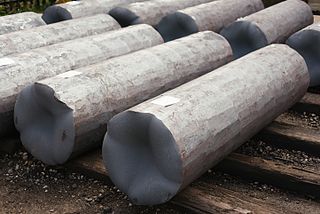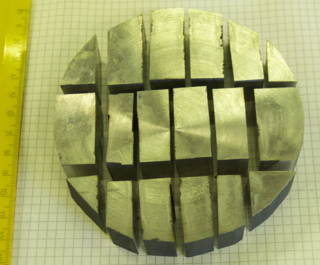Related Research Articles

Stainless steel, also known as inox, corrosion-resistant steel (CRES) and rustless steel, is an alloy of iron that is resistant to rusting and corrosion. It contains iron with chromium and other elements such as molybdenum, carbon, nickel and nitrogen depending on its specific use and cost. Stainless steel's resistance to corrosion results from the 10.5%, or more, chromium content which forms a passive film that can protect the material and self-heal in the presence of oxygen.
Surgical stainless steel is a grade of stainless steel used in biomedical applications. The most common "surgical steels" are austenitic SAE 316 stainless and martensitic SAE 440, SAE 420, and 17-4 stainless steels. There is no formal definition on what constitutes a "surgical stainless steel", so product manufacturers and distributors often apply the term to refer to any grade of corrosion resistant steel.

Monel is a group of alloys of nickel and copper, with small amounts of iron, manganese, carbon, and silicon. Monel is not a cupronickel alloy because it has less than 60% copper.
In modern Western body piercing, a wide variety of materials are used. Some cannot be autoclaved, and others may induce allergic reactions, or harbour bacteria. Certain countries, such as those belonging to the EU, have legal regulations specifying which materials can be used in new piercings.

Titanium alloys are alloys that contain a mixture of titanium and other chemical elements. Such alloys have very high tensile strength and toughness. They are light in weight, have extraordinary corrosion resistance and the ability to withstand extreme temperatures. However, the high cost of processing limits their use to military applications, aircraft, spacecraft, bicycles, medical devices, jewelry, highly stressed components such as connecting rods on expensive sports cars and some premium sports equipment and consumer electronics.
Alloy 20 is an austenitic stainless steel containing less than 50% iron developed for applications involving sulfuric acid. Its corrosion resistance also finds other uses in the chemical, petrochemical, power generation, and plastics industries. Alloy 20 resists pitting and chloride ion corrosion, better than 304 stainless steel and on par with 316L stainless steel. Its copper content protects it from sulfuric acid. Alloy 20 is often chosen to solve stress corrosion cracking problems, which may occur with 316L stainless. Alloy of the same name with the designation "Cb-3" indicates niobium stabilized.
Marine grade stainless alloys typically contain molybdenum to resist the corrosive effects of NaCl or salt in seawater. Concentrations of salt in seawater can vary, and splash zones can cause concentrations to increase dramatically from the spray and evaporation.

Austenitic stainless steel is one of the five classes of stainless steel by crystalline structure. Its primary crystalline structure is austenite and it prevents steels from being hardenable by heat treatment and makes them essentially non-magnetic. This structure is achieved by adding enough austenite-stabilizing elements such as nickel, manganese and nitrogen. The Incoloy family of alloys belong to the category of super austenitic stainless steels.

The SAE steel grades system is a standard alloy numbering system for steel grades maintained by SAE International.
Michael A. Streicher was an American metallurgist and engineer who became internationally recognized for his work on the testing and development of corrosion-resistant stainless steel alloys. He published widely in technical journals and textbooks and received numerous patents for his inventions.
Zeron 100 is a super duplex stainless steel developed by Rolled Alloys. The alloy has excellent corrosion resistance combined with high strength. It typically contains 25% chromium and 7% nickel and 3.6% molybdenum along with copper and tungsten additions. Zeron 100 has a 50–50 austenitic–ferritic structure. It also has greater resistance to chloride pitting, crevice corrosion and stress corrosion cracking than exhibited by the standard 300 series stainless steels.
Incoloy refers to a range of superalloys now produced by the Special Metals Corporation (SMC) group of companies and created with a trademark by the Inco company in 1952. Originally Inco protected these alloys by patent. In 2000, the SMC published a 61-page document entitled "High-Performance Alloys for Resistance to Aqueous Corrosion" highlighting Incoloy, as well as Monel and Inconel products, and their use in fluid environments such as sulfuric acid, hydrochloric acid, hydrofluoric acid, phosphoric acid, nitric acid, other acids as well as freshwater environments.
SAF 2205, is a Alleima-owned trademark for a 22Cr duplex (ferritic-austenitic) stainless steel. SAF derives from Sandvik Austenite Ferrite. The nominal chemical composition of SAF 2205 is 22% chromium, 5% nickel, 3.2% molybdenum and other alloying elements such as nitrogen and manganese. The UNS designation for SAF 2205 is S31803/S32205 and the EN steel no. is 1.4462. SAF 2205 or Duplex 2205 is often used as an alternative to expensive 904L stainless steel owing to similar properties but cheaper ingredients. Duplex stainless steel is available in multiple forms like bars, billets, pipes, tubes, sheets, plates and even processed to fittings and flanges.
SAF 2507, is a Alleima-owned trademark for a 25Cr duplex (ferritic-austenitic) stainless steel. The nominal chemical composition of SAF 2507 is 25% chromium, 7% nickel, 4% molybdenum and other alloying elements such as nitrogen and manganese. The UNS designation for SAF 2507 is S32750 and the EN steel no. is 1.4410. SAF derives from Sandvik Austenite Ferrite.

Duplex stainless steels are a family of stainless steels. These are called duplex grades because their metallurgical structure consists of two phases, austenite and ferrite in roughly equal proportions. They are designed to provide better corrosion resistance, particularly chloride stress corrosion and chloride pitting corrosion, and higher strength than standard austenitic stainless steels such as type A2/304 or A4/316. The main differences in composition, when compared with an austenitic stainless steel is that the duplex steels have a higher chromium content, 20–28%; higher molybdenum, up to 5%; lower nickel, up to 9% and 0.05–0.50% nitrogen. Both the low nickel content and the high strength give significant cost benefits. They are therefore used extensively in the offshore oil and gas industry for pipework systems, manifolds, risers, etc. and in the petrochemical industry in the form of pipelines and pressure vessels. In addition to the improved corrosion resistance compared with the 300 series duplex stainless steels also have higher strength. For example, a Type 304 stainless steel has a 0.2% proof strength in the region of 280 MPa (41 ksi), a 22%Cr duplex stainless steel a minimum 0.2% proof strength of some 450 MPa (65 ksi) and a superduplex grade a minimum of 550 MPa (80 ksi).

SAE 304 stainless steel is the most common stainless steel. It is an alloy of iron, carbon, chromium and nickel. It is an austenitic stainless steel, and is therefore not magnetic. It is less electrically and thermally conductive than carbon steel. It has a higher corrosion resistance than regular steel and is widely used because of the ease in which it is formed into various shapes.

SAE 316L grade stainless steel, sometimes referred to as A4 stainless steel or marine grade stainless steel, is the second most common austenitic stainless steel after 304/A2 stainless steel. Its primary alloying constituents after iron, are chromium, nickel (10–12%) and molybdenum (2–3%), with small (<1%) quantities of silicon, phosphorus & sulfur also present. The addition of molybdenum provides greater corrosion resistance than 304, with respect to localized corrosive attack by chlorides and to general corrosion by reducing acids, such as sulfuric acid. 316L grade is the low carbon version of 316 stainless steel. When cold worked, 316 can produce high yield and tensile strengths similar to Duplex stainless grades.
904L is an austenitic stainless steel. It is softer than 316L, but its molybdenum addition gives it superior resistance to localized attack by chlorides and greater resistance reducing acids; in particular, its copper addition gives it useful corrosion resistance to all concentrations of sulfuric acid. Its high alloying content also gives it greater resistance to chloride stress corrosion cracking, but it is still susceptible. Its low carbon content makes it resistant to sensitization by welding and which prevents intergranular corrosion.

Ferritic stainless steel forms one of the five stainless steel families, the other four being austenitic, martensitic, duplex stainless steels, and precipitation hardened. For example, many of AISI 400-series of stainless steels are ferritic steels. By comparison with austenitic types, these are less hardenable by cold working, less weldable, and should not be used at cryogenic temperatures. Some types, like the 430, have excellent corrosion resistance and are very heat tolerant.
References
- ↑ "AL-6XN Super Alloy - Super-Austenitic Stainless Steel". Central States Industrial. Retrieved 16 April 2021.
- ↑ "AL-6XN Superaustenitic Stainless Steel, UNS N08367, Product Documents". atimetals.com/. Retrieved 15 August 2020.
- 1 2 3 4 "AL-6XN Alloy Page". Rolled Alloys Inc. Archived from the original on 4 May 2013. Retrieved 12 April 2013.